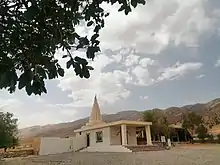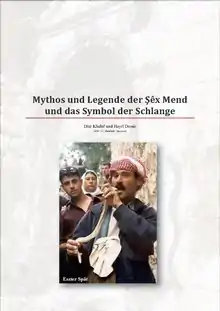Sheikh Mand
Sheikh Mand or Sheikh Mend (Kurdish: Şêx Mend[1]) was a 13th-century Yazidi saint. He is the son of Fakhraddin and thus belongs to the Shamseni lineage of sheikhs. His sister was Khatuna Fekhra, revered today as one of the most important Yazidi female saints.[2][3]
Sheikh Mand | |
|---|---|
Şêx Mend | |
| Resting place | Iraq |
| Other names | Lord of Snakes |
| Parent(s) |
|
| Relatives | Xatûna Fexra (sister) |
| Family | Shemsani lineage |
| Part of a series on Yazidi religion and Yazidi nationalism |
|---|
 |

Quba Sheikh Mand, a shrine dedicated to Sheikh Mand in Sinjar, Iraq

Myth and legend of the Şêx Mend and the symbol of the snake (In German).
He was the prince of the Emirate of Kilis during the 13th century.[4]
Association with snakes
Sheikh Mand is traditionally considered to be a patron of snakes. His shrine at Lalish is said to contain a cave that is full of snakes.[2][5]
References
- Omarkhali, Khanna (2017). The Yezidi religious textual tradition, from oral to written: categories, transmission, scripturalisation, and canonisation of the Yezidi oral religious texts. Wiesbaden: Harrassowitz Verlag. ISBN 978-3-447-10856-0. OCLC 994778968.
- Kreyenbroek, Philip (1995). Yezidism: its background, observances, and textual tradition. Lewiston NY: E. Mellen Press. ISBN 0-7734-9004-3. OCLC 31377794.
- Kreyenbroek, Philip (2005). God and Sheikh Adi are perfect: sacred poems and religious narratives from the Yezidi tradition. Wiesbaden: Harrassowitz Verlag. ISBN 978-3-447-05300-6. OCLC 63127403.
- Izady, Mehrdad R. (2005). The Sharafnama, or, The history of the Kurdish nation, 1597. Costa Mesa, Calif.: Mazda. ISBN 1-56859-074-1.
- Diar Khalaf and Hayri Demir. 2013. Mythos und Legende der Shex Mend und das Symbol der Schlange (Myth and legend of the Şêx Mend and the symbol of the snake) (in German).
This article is issued from Wikipedia. The text is licensed under Creative Commons - Attribution - Sharealike. Additional terms may apply for the media files.